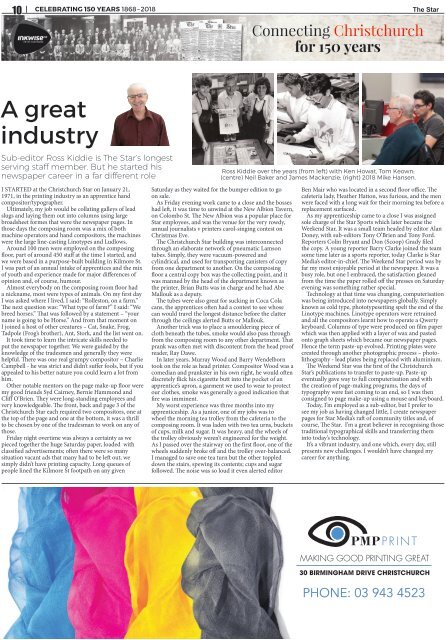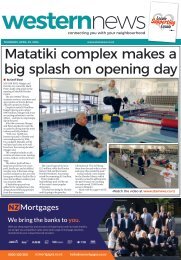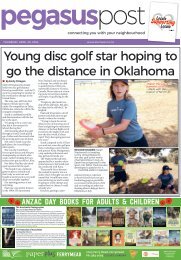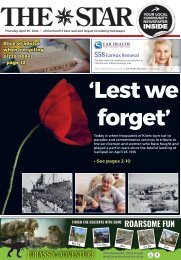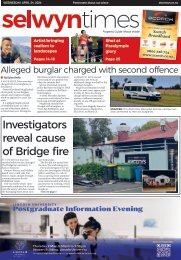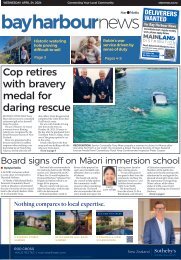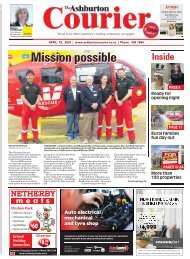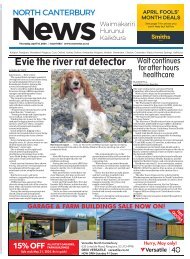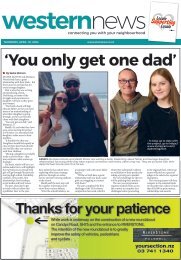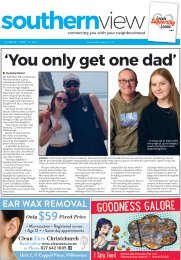The Star: July 05, 2018
You also want an ePaper? Increase the reach of your titles
YUMPU automatically turns print PDFs into web optimized ePapers that Google loves.
10<br />
CELEBRATING 150 YEARS 1868 – <strong>2018</strong><br />
Connecting Christchurch<br />
for 150 years<br />
<strong>The</strong> <strong>Star</strong><br />
A great<br />
industry<br />
Sub-editor Ross Kiddie is <strong>The</strong> <strong>Star</strong>’s longest<br />
serving staff member. But he started his<br />
newspaper career in a far different role<br />
I STARTED at the Christchurch <strong>Star</strong> on January 21,<br />
1971, in the printing industry as an apprentice hand<br />
compositor/typographer.<br />
Ultimately, my job would be collating galleys of lead<br />
slugs and laying them out into columns using large<br />
broadsheet formes that were the newspaper pages. In<br />
those days the composing room was a mix of both<br />
machine operators and hand compositors, the machines<br />
were the large line-casting Linotypes and Ludlows.<br />
Around 100 men were employed on the composing<br />
floor, part of around 450 staff at the time I started, and<br />
we were based in a purpose-built building in Kilmore St.<br />
I was part of an annual intake of apprentices and the mix<br />
of youth and experience made for major differences of<br />
opinion and, of course, humour.<br />
Almost everybody on the composing room floor had<br />
a nickname, most were types of animals. On my first day<br />
I was asked where I lived, I said: “Rolleston, on a farm.’’<br />
<strong>The</strong> next question was: “What type of farm?’’ I said: “We<br />
breed horses.’’ That was followed by a statement – “your<br />
name is going to be Horse.’’ And from that moment on<br />
I joined a host of other creatures – Cat, Snake, Frog,<br />
Tadpole (Frog’s brother), Ant, Stork, and the list went on.<br />
It took time to learn the intricate skills needed to<br />
put the newspaper together. We were guided by the<br />
knowledge of the tradesmen and generally they were<br />
helpful. <strong>The</strong>re was one real grumpy compositor – Charlie<br />
Campbell - he was strict and didn’t suffer fools, but if you<br />
appealed to his better nature you could learn a lot from<br />
him.<br />
Other notable mentors on the page make-up floor were<br />
my good friends Syd Cairney, Bernie Hammond and<br />
Cliff O’Brien. <strong>The</strong>y were long-standing employees and<br />
very knowledgeable. <strong>The</strong> front, back and page 3 of the<br />
Christchurch <strong>Star</strong> each required two compositors, one at<br />
the top of the page and one at the bottom, it was a thrill<br />
to be chosen by one of the tradesman to work on any of<br />
those.<br />
Friday night overtime was always a certainty as we<br />
pieced together the huge Saturday paper, loaded with<br />
classified advertisements; often there were so many<br />
situation vacant ads that many had to be left out, we<br />
simply didn’t have printing capacity. Long queues of<br />
people lined the Kilmore St footpath on any given<br />
Ross Kiddie over the years (from left) with Ken Howat, Tom Keown;<br />
(centre) Neil Baker and James Mackenzie; (right) <strong>2018</strong> Mike Hansen.<br />
Saturday as they waited for the bumper edition to go<br />
on sale.<br />
As Friday evening work came to a close and the bosses<br />
had left, it was time to unwind at the New Albion Tavern,<br />
on Colombo St. <strong>The</strong> New Albion was a popular place for<br />
<strong>Star</strong> employees, and was the venue for the very rowdy,<br />
annual journalists v printers carol-singing contest on<br />
Christmas Eve.<br />
<strong>The</strong> Christchurch <strong>Star</strong> building was interconnected<br />
through an elaborate network of pneumatic Lamson<br />
tubes. Simply, they were vacuum-powered and<br />
cylindrical, and used for transporting canisters of copy<br />
from one department to another. On the composing<br />
floor a central copy box was the collecting point, and it<br />
was manned by the head of the department known as<br />
the printer. Brian Butts was in charge and he had Abe<br />
Mallouk as a deputy.<br />
<strong>The</strong> tubes were also great for sucking in Coca Cola<br />
cans, the apprentices often had a contest to see whose<br />
can would travel the longest distance before the clatter<br />
through the ceilings alerted Butts or Mallouk.<br />
Another trick was to place a smouldering piece of<br />
cloth beneath the tubes, smoke would also pass through<br />
from the composing room to any other department. That<br />
prank was often met with discontent from the head proof<br />
reader, Ray Dawe.<br />
In later years, Murray Wood and Barry Wendelborn<br />
took on the role as head printer. Compositor Wood was a<br />
comedian and prankster in his own right, he would often<br />
discretely flick his cigarette butt into the pocket of an<br />
apprentice’s apron, a garment we used to wear to protect<br />
our clothes, smoke was generally a good indication that<br />
fire was imminent.<br />
My worst experience was three months into my<br />
apprenticeship. As a junior, one of my jobs was to<br />
wheel the morning tea trolley from the cafeteria to the<br />
composing room. It was laden with two tea urns, buckets<br />
of cups, milk and sugar. It was heavy, and the wheels of<br />
the trolley obviously weren’t engineered for the weight.<br />
As I passed over the stairway on the first floor, one of the<br />
wheels suddenly broke off and the trolley over-balanced.<br />
I managed to save one tea turn but the other toppled<br />
down the stairs, spewing its contents; cups and sugar<br />
followed. <strong>The</strong> noise was so loud it even alerted editor<br />
Ben Mair who was located in a second floor office. <strong>The</strong><br />
cafeteria lady, Heather Hatton, was furious, and the men<br />
were faced with a long wait for their morning tea before a<br />
replacement surfaced.<br />
As my apprenticeship came to a close I was assigned<br />
sole charge of the <strong>Star</strong> Sports which later became the<br />
Weekend <strong>Star</strong>. It was a small team headed by editor Alan<br />
Doney, with sub-editors Tony O’Brien and Tony Ford.<br />
Reporters Colin Bryant and Don (Scoop) Grady filed<br />
the copy. A young reporter Barry Clarke joined the team<br />
some time later as a sports reporter, today Clarke is <strong>Star</strong><br />
Media’s editor-in-chief. <strong>The</strong> Weekend <strong>Star</strong> period was by<br />
far my most enjoyable period at the newspaper. It was a<br />
busy role, but one I embraced, the satisfaction gleaned<br />
from the time the paper rolled off the presses on Saturday<br />
evening was something rather special.<br />
Technology at that time was changing, computerisation<br />
was being introduced into newspapers globally. Simply<br />
known as cold type, phototypesetting spelt the end of the<br />
Linotype machines. Linotype operators were retrained<br />
and all the compositors learnt how to operate a Qwerty<br />
keyboard. Columns of type were produced on film paper<br />
which was then applied with a layer of wax and pasted<br />
onto graph sheets which became our newspaper pages.<br />
Hence the term paste-up evolved. Printing plates were<br />
created through another photographic process – photolithography<br />
- lead plates being replaced with aluminium.<br />
<strong>The</strong> Weekend <strong>Star</strong> was the first of the Christchurch<br />
<strong>Star</strong>’s publications to transfer to paste-up. Paste-up<br />
eventually gave way to full computerisation and with<br />
the creation of page-making programs, the days of<br />
typography were fast coming to an end, so I was then<br />
consigned to page make-up using a mouse and keyboard.<br />
Today, I’m employed as a sub-editor, but I prefer to<br />
see my job as having changed little, I create newspaper<br />
pages for <strong>Star</strong> Media’s raft of community titles and, of<br />
course, <strong>The</strong> <strong>Star</strong>. I’m a great believer in recognising those<br />
traditional typographical skills and transferring them<br />
into today’s technology.<br />
It’s a vibrant industry, and one which, every day, still<br />
presents new challenges. I wouldn’t have changed my<br />
career for anything.<br />
PHONE: 03 943 4523


